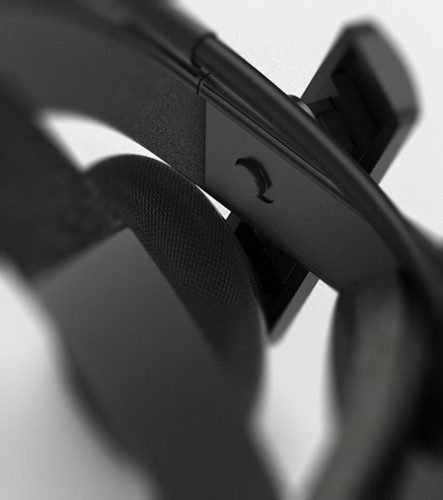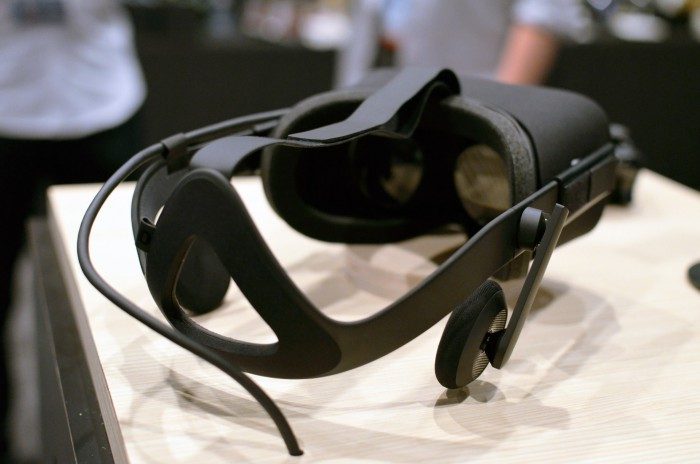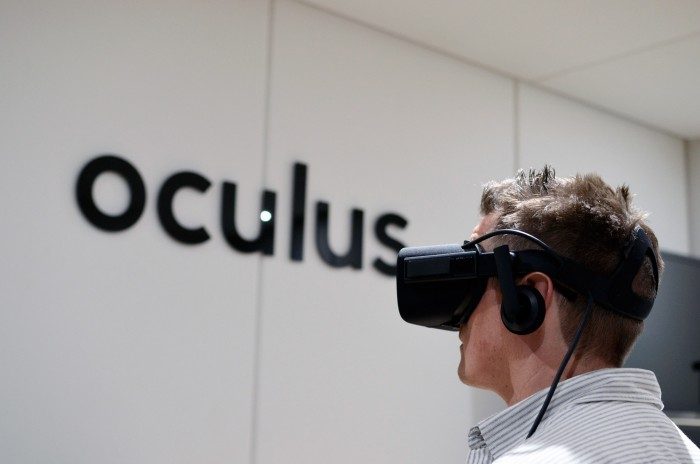At E3 2015 we got our eyes and ears on the consumer Oculus Rift, which now of course includes integrated headphones. Here’s why we think you may consider ditching your existing gaming headset in favour of Oculus’ alternative.
Oculus’ inaugural ‘Connect’ developer conference in September last year introduced the world to the closest glimpse at the company’s vision for consumer virtual reality hardware. The Crescent Bay feature prototype introduced a number of enhancements including 360 positional tracking and (as would later transpire) a dual-panel display.
But Connect 2014 was also where the company also began to emphasise how important they felt audio was to enhancing presence in VR experiences. To that end, Crescent Bay also featured a set of integrated, detachable high-grade headphones – designed as an optional replacement for your heavy, ‘gaming grade’ headset.
Partially this move was to enhance the user’s physical and tactile experience and general convenience. Frankly, having to deal with headphones after you’ve donned your VR Headset is a pain in the arse and this solution neatly removes that hassle. But mainly, it gave Oculus control over the entire audio pipeline, able to ensure the audio experience reaches the user as intended. The headset even ships with a custom DAC (Digital to Analogue Converter), a solution popular with audiophiles wanting to bypass cheap onboard DACs in portable equipment to boost sound quality.
See Also: Oculus Rift ‘Crescent Bay’ is Designed for Audiophiles – Here’s Why that’s Important for VR
Having now spent a fair amount of time with both the consumer Oculus Rift (or at least the engineering samples present at E3 last month) and the Crescent Bay (the consumer Rift’s closest relative) I’m happy to report that Oculus custom audio pipeline is extremely good and may even persuade you to ditch your existing, likely bulky headset during Rift VR sessions.
Ergonomics, Comfort and Isolation
Carbon, the industrial design house responsible for the original Xbox controller and now part of the Oculus corporate family, have excelled themselves faced with a tough brief.
The headphones ‘rest’ comfortable over your ears once the Rift is in place but, as they’re anchored to the main head harness don’t press onto your ears. This means their supremely comfortable when in place and you certainly won’t miss the bulk and the weight of your chosen headphones, with no weight pressing down on the top of your head.
 This all may sound rather trivial, but when the aim of the game here is to immerse yourself in another world, constant physical reminders this is happening courtesy of heavy hardware is a barrier to presence – ergo, removing that weight removes that barrier. Given that the Rift’s integrated headphones are suspended from the headset with none of the inwards pressure found on standard headphone cans, it’s able to lessen that perceived burden yet further. The gauze covering the ‘phones felt nice and breathable too, ready for long comfortable play sessions.
This all may sound rather trivial, but when the aim of the game here is to immerse yourself in another world, constant physical reminders this is happening courtesy of heavy hardware is a barrier to presence – ergo, removing that weight removes that barrier. Given that the Rift’s integrated headphones are suspended from the headset with none of the inwards pressure found on standard headphone cans, it’s able to lessen that perceived burden yet further. The gauze covering the ‘phones felt nice and breathable too, ready for long comfortable play sessions.
The ‘phones aren’t circumaural (i.e. they don’t cover your entire ear) so surely sound isolation is an issue? Yes it it, but not nearly as bad as you might think. I frequently had to rotate the ‘phones from my ears when demonstrators were trying to tell me something during my time at E3, and when you’re immersed in the world, at a decent volume the ‘phones do a good job at isolating you from ambient noise. They’re never going to be up to the best closed-back circumaural cans, or indeed in-ear monitors in this regard, so if your play environment is noisy, you may find them lacking here. But considering their physical limitations, they did a pretty good job.
The headphones themselves are clipped to the side of the Rift’s harness at custom clip-in termination points – meaning you can remove them and drop in your own headphones (albeit via a separate soundcard / headphone jack point). It’ll be interesting to see if Oculus license / allow 3rd party manufacturers to produce ‘upgraded’ cans for use on the headset, it seems entirely feasible and definitely welcome.
Finally, being free’d from that extra cable / set of cables from a standard set of headphones means less tangles and accidental disconnection of chords – something that’s happened countless times during some of my more ‘spirited’ VR adventures.
Audio Quality
As far as we can tell, the audio drivers found on Crescent Bay are the same as the engineering sample consumer Rift Oculus were using as demonstrators. With that assumption in place, I’ve now spent a good amount of time across multiple VR experiences at E3 – my best opportunity yet to quantify the Rift’s audio prowess.
The news is good. The units are clear, crisp and transparent. It seems to me that the drivers found on the Rift are designed for purity and transparency – i.e. reproducing audio frequencies as accurately as possible avoiding colouration or added ‘character’ introduced by the hardware.
They have the ‘feel’ of neutral studio monitors, which translates here as crisp treble / highs free from brightness and sharpness. Midrange seems nicely refined, with a good timbre that’s seemingly entirely free of sibilants (the annoying ‘sss’ artefacts that can be emphasised with speech). Given the small size of the Rift’s drivers, bass extension was predictably not very low, but what was there was controlled and absolutely not overblown, with no detectable boom.
If you’re the kind of person who enjoys overly warm bass, the kind championed on the popular ‘Beats by Dre’ kit out there, you’ll likely be disappointed here. The Rift’s units are designed for recreating spatial audio, and this lack of overblown character will likely be a boon to audio engineers out there, charged with delivering compelling and immersive spatial audio mixes for VR experiences.
One thing I still feel unable to comment on just yet is the Oculus’ Audio API and processing pipeline. Utilising licensed spatial audio techniques from VisiSonics’ RealSpace audio system, it’s designed to add a believable 3D audio mix to VR experiences, in theory enhancing the feeling of presence. However, E3’s noisy show floor and meeting rooms were the worst places to try and appreciate such mixes and I’m reserving judgement on imaging and such like until I’ve tried the hardware in the right environment.
It’s highly likely that if you’re reading this, you have a dedicated set of headphones with which experience game and VR audio. If it’s a ‘gaming headset’ it’s highly likely that the Oculus Rift will deliver cleaner, more accurate and more transparent sound than your current unit. Gaming headsets, especially those that claim ‘surround’ features, can often be a very mixed bunch as far as audio authenticity is concerned – rarely designed with subtlety or accuracy in mind.
Don’t forget too that the consumer Rift also has a built in microphone – we used this in our time with the Oculus Touch, so in case you had concerns that you’d lose voice comms functionality when in VR, this should be taken care of. At this stage we’re not sure how the mic is presented to the OS however, so some reserve of judgement is probably wise just for now.
Will you prefer Oculus’ audio over your current headset? As with anything ‘HiFi’ that’s going to be something you’ll have to discover for yourself. On the question of whether the Oculus Rift can deliver a more accurate and transparent sound, one that’s better able to deliver spatial audio to you – it’s likely that they probably do. And when you factor in the other benefits highlighted above: no wires, less weight, less hassle – you may well find your consumer Rift VR sessions are left to the onboard audio solution in favour of your standard gaming cans.










